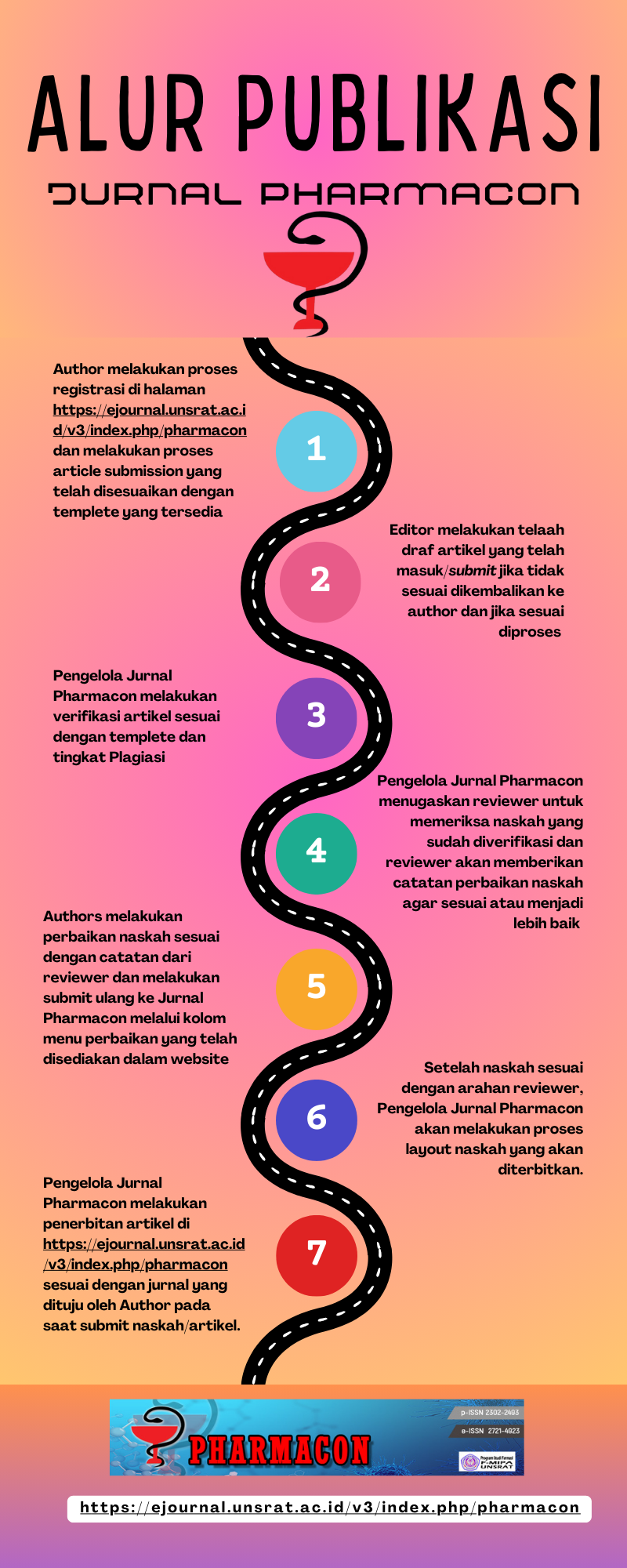Antibacterial Potential Test of Cream Preparation of Ethanol Extract of Matoa Stem Bark (Pometia pinnata) against Staphylococcus aureus.
DOI:
https://doi.org/10.35799/pha.12.2023.42190Keywords:
Antibacterial, matoa (Pometia pinnata), cream, Staphylococcus aureus.Abstract
Skin diseases can be caused by several factors, one of which is a bacterial infection. One of the bacteria that causes infection is Staphylococcus aureus. The results of previous studies showed that the ethanolic extract of the bark of matoa (Pometia pinnata) had antibacterial potential. This study aims to test the quality of cream preparations including homogeneity test, organoleptic test, pH test, adhesion test and dispersibility test, as well as to test the antibacterial activity of cream preparations ethanol extract of matoa stem bark. The matoa bark extract was obtained by maceration method using 95% ethanol as solvent. The antibacterial activity test was carried out using the well method, with a concentration variation of 0.5%, 1.5%, 2.5% and 3.5%. The test results showed that all the parameters of the test preparation, namely homogeneity test, organoleptic test, pH test, adhesion test and spreadability test met the requirements of the quality of the preparation. Antibacterial testing showed cream preparations with a concentration of 3.5% produced the largest inhibition zone of 8.66 mm which was included in the category of moderate inhibition.
References
Alam, N., E. Tambaru, dan A. Abdullah. 2015. Keragaman Jamur Basiomycetes Makroskopis di Kawasan Hutan Pendidikan Universitas Hasanuddin Bengo-bengo Kecamatan Cenrana Kabupaten Maros. Jurnal Alam dan Lingkungan. 1(1): 1-7.
Badan Standar Nasional, 1998. SNI 16-4399-1996 Sediaan Krim Tabir Surya. BSN, Jakarta.
Davis, W.W., and T.R. Stout. 1971. Disc Plate Methods of Microbiology. 22(4): 659-665.
Departemen Kesehatan Republik Indonesia. 1995. Farmakope Indonesia, Edisi IV. Jakarta: Departemen Kesehatan Republik Indonesia.
Departemen Kesehatan Republik Indonesia. 1979. Farmakope Indonesia. Edisi III. Jakarta: Departemen Kesehatan Republik Indonesia.
Departemen Kesehatan Republik Indonesia. 1980. Kodeks Kosmetika Indonesia. Volume 1. Jakarta: Departemen Kesehatan Republik Indonesia.
Ngajow, M., A. Jemmy, dan K. Vanda. 2013. Pengaruh antibakteri ekstrak kulit batang matoa (Pometia pinnata) terhadap bakteri Staphylococcus aureus secara in vitro. Jurnal MIPA Unsrat Online. 2(2): 128-132.
Sudarmono. 2001. Matoa (Pometia pinnata Forst & Forst): Keragaman Jenis dan Potensi. Prosiding Seminar Sehari Menggali Potensi dan Meningkatkan Prospek Tanaman Hortikultura Menuju Ketahanan Pangan. LIPI.
Ulaen, S.P.J., Y. Banne, dan R.A. Suatan. 2012. Pembuatan Salep Anti Jerawat dari Ekstrak Rimpang Temulawak (Curcuma xanthorrhiza Roxb.). Jurnal Ilmiah Farmasi. Politeknik Kesehatan Kemenkes Manado, Manado. 3(2): 45-49.
Wasitaatmadja, S. M. 1997. Penuntun Ilmu Kosmetik Medik. Universitas Indonesia, Jakarta.
Zeiniyah, S., Eva, S.S., and Rusnaeni. 2019. Antibacterial Activity Test of the Liquid Soap of Matoa’s Stem Bark (Pometia pinnata) against Staphylococcus aureus and Escherichia coli. MAT Journals. 2(1): 40-46.
Downloads
Published
How to Cite
Issue
Section
License
Copyright (c) 2023 PHARMACON

This work is licensed under a Creative Commons Attribution-NonCommercial 4.0 International License.
Authors who publish with this journal agree to the following terms:
- Authors retain copyright and grant the journal right of first publication with the work simultaneously licensed under a Creative Commons Attribution-NonCommercial 4.0 International License that allows others to share the work with an acknowledgement of the work's authorship and initial publication in this journal.
- Authors are permitted and encouraged to post their work online (e.g., in institutional repositories or on their website) prior to and during the submission process, as it can lead to productive exchanges, as well as earlier and greater citation of published work (See The Effect of Open Access)










